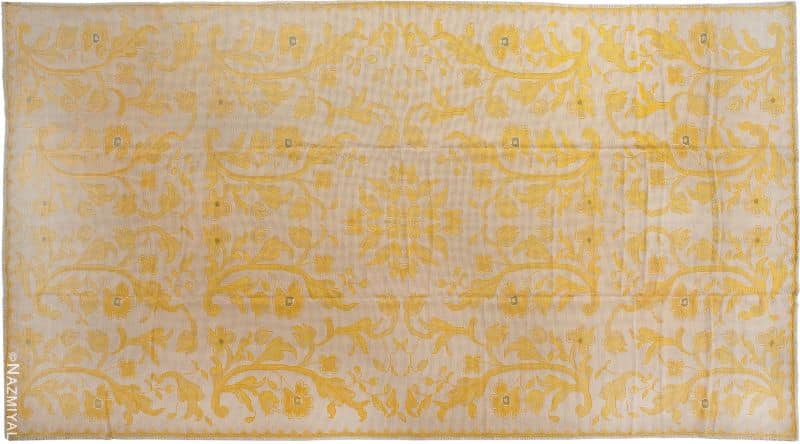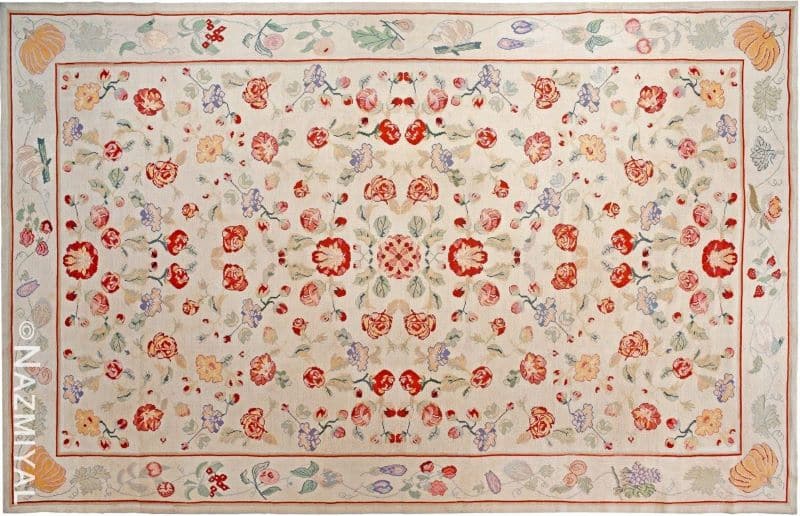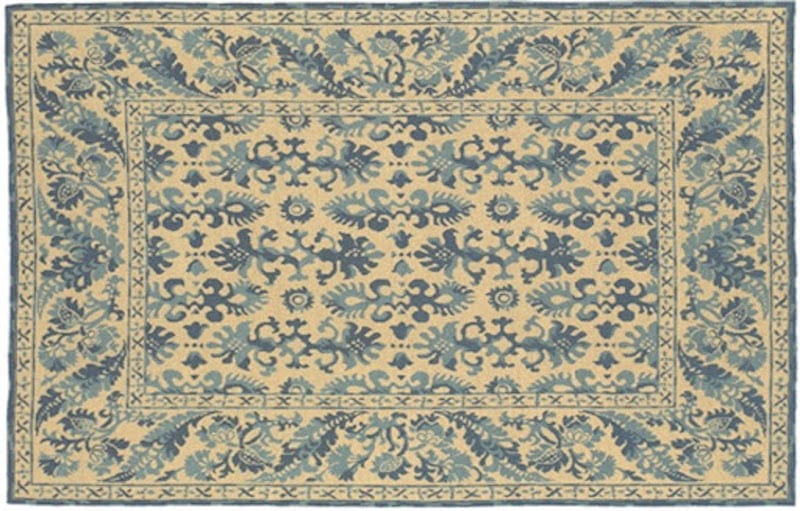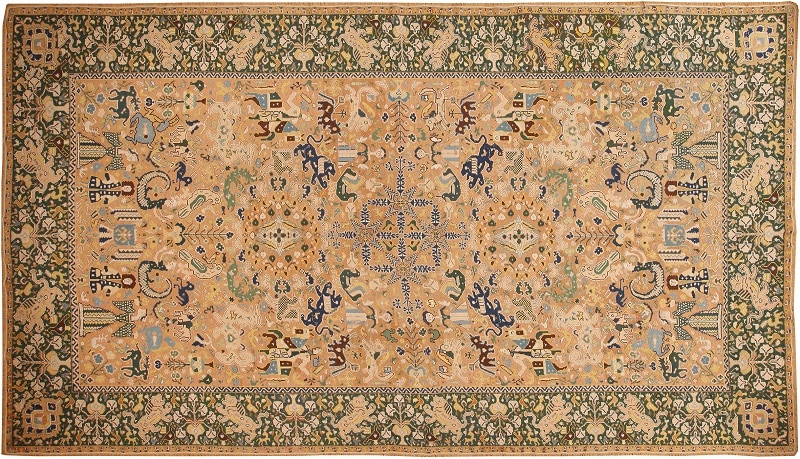Portuguese Needlepoint Rugs
Below you can view our current antique collection of Portuguese Needlepoint rugs and carpets:
Antique Alpujarra Rug 2605
$2,900.00Size: 5 ft 7 in x 6 ft 10 in (1.7 m x 2.08 m)
Portuguese Needlepoint Rugs: A Story of Struggle Turned Into Artwork
When many people think of carpets, what comes to mind are the pile rugs and traditional kilims of the middle east. Kilims are similar to a tapestry weaving and have a flat weave, as opposed to a soft, plush raised pile. However, these are not the only two methods used to create beautiful carpets. Needlepoint is another traditional craft that has a special place in the historical traditions of carpet weaving. Portuguese needlepoint rugs are a special class of carpets that have a unique history, particularly in the village of Arraiolos. Let’s explore the story behind these beautiful carpets.
What is needlepoint?
First off, let us examine the differences between needlepoint and traditional carpet weaving methods. Traditional carpet weaving is performed on a warp that is strung vertically. Pile carpets are created using rows of regular weaving and alternating them with rows of knots to produce the design. Kilims are produced in a similar way, only they do not use the rows of pile knots. Needlepoint, on the other hand, is produced using a tapestry needle and creating stitches on an evenly spaced canvas.
The origins of needlepoint are considered to go back to 1,500 BC when Egyptians used diagonal stitches to create the seams of their tents. This eventually evolved into tapestry weaving. Some of the finest examples of tapestry weaving include The Lady and the Unicorn, produced in the 15th century. However, tapestry weaving is still created on a loom using a vertical warp. Needlepoint, as we refer to it today, began in the 17th century and did not use a loom.
During this time, the stitches were worked on a stiff canvas that was able to withstand use in practical items such as furniture and shoes. By the 19th century, needlepoint had reached a new height of popularity and was considered a fine ladies’ art and an appropriate occupation for ladies of refinement and taste. The designs used in needlepoint changed, but the basic technique remained the same.

Large Vintage Portuguese Needlepoint Rug
Needlepoint involves placing diagonal stitches on the canvas. Sometimes variations on these stitches are used using the intersection of the stitches and combinations of longer and shorter stitches. However, for the most part, the basic concept of the stitching is the same. The pattern is created by changing colors. Some pieces use extremely fine canvas and can achieve exceptional levels of intricate detail and artistic skill.
Portuguese Needlepoint Rugs
The durability of needlepoint makes it suitable for the creation of carpets and floor coverings. The tradition of creating needlepoint rugs in Portugal has a fascinating story that begins back in 1492 with Queen Isabella of Spain. During the Renaissance, needlepoint was used to create chair coverings, footstools, pillows, bed headboards, floor coverings, and even some clothing pieces. It was durable and could stand up to heavy use.
Spain had a 700-year history of occupation by the Moors, and it had a significant Jewish population as well. These ethnic groups played an important role in Spanish history and made a significant contribution to the culture. They were an integral part of Spanish society, but in 1492 Queen Isabella issued a proclamation that expelled the Moors and Jewish from Spain. The proclamation called for their rapid departure, and they had little time or ability to take many of their possessions with them. They boarded ships and headed to other parts of the world where they had few ties and few resources to establish themselves.
One of these groups was a community of Jews who landed in Arraiolos, in the southern part of Portugal. They had few skills or resources to make a living, but the women brought their knowledge of needlepoint with them and began creating carpets to sell as a means of survival. Journals from the Renaissance talk about groups of women in the village working together outside under shade trees and on their front porch steps as they created these beautiful needlepoint carpets.

Floral Antique Portuguese Needlepoint Rug
Since that time, the needlepoint carpets of Arraiolos have remained an important part of the village tradition. The designs of the carpets reflect those that the original Jewish settlers brought with them from Spain. Many of them have similar patterns to the tile work and hand-painted azulejo tiles that are found throughout Spanish and Portuguese architecture. Many of these tiled designs remained popular throughout the centuries, but the women eventually began to incorporate their own flourishes and ideas into the work. However, many of the carpets designed to reflect the original Spanish architecture are still popular today.
A Beautiful Tradition Continues
Some of the most beautiful Portuguese needlepoint carpets are antiques, but this historical craft did not die out and is still practiced by the traditional women weavers of the village today. Each carpet takes many months to create, and every single stitch is created by hand. They are a unique expression of the Portuguese needlewomen who created them. They are the culmination of traditional designs with a few details added from the imagination of the artist.
These carpets are made from thick, durable wool and will last for quite some time. The canvas is often woven jute or linen. The colors are often created using traditional vegetable dyes that are available locally. Each carpet is the result of many hours of work, from shearing the sheep to finishing the final piece. These carpets are large scale works and take many hours of dedication to create, but they are worth it for their beauty. They reflect centuries of traditions and the story of a people who made the best of their circumstances to create exquisite artwork in the colors and designs.
If you visit the village today, you can still see women sitting around in groups creating these stunning needlework creations. The colors are often reminiscent of a beautiful garden. The color palette is extensive and includes brilliant blues, pinks, violets, greens, oranges, reds, browns, and ivories. They use various shades and hues that allow them to create areas of light and shadow. This gives the work a three-dimensional quality and a sense of realism. The designs range from delicate florals to geometrics. Even with the more creative pieces, you can still see a reflection of the tiles that inspired them.
An antique Portuguese needlepoint rug is the perfect addition to a historical or traditional room design. They can add an air of authenticity to a traditional room and are perfect for Victorian, Arts and Crafts, and Art Deco designs. However, these beautiful works need not be limited to historical design settings.
Many of them have bold geometrics and are the perfect addition to a modern or contemporary decor. They also add texture and color to an informal or Boho chic design. Regardless of where you choose to use them, a Portuguese needlepoint rug is something a bit unusual and adds a charge of character to the room. They are the perfect piece for many interior designs and are the creations of a people whose tale of struggle transformed into something beautiful.
The Story of Arraiolos Rugs From Portugal
Arraiolos rugs represent the epitome of the Portuguese textile industry, but their origin dates back to a place far from their namesake. To understand what makes these sought-after rugs so special, we must look back at their rich and interesting history. In so doing we will discover how lucky we are to still be able to see these amazing artworks being made today.
The Arrival in Arraiolos
It is commonly thought that the best and most beloved carpet designs originated in Persia centuries ago. So how did the Arraiolos rug get its name from a town in Portugal? The answer involves digging into the political shifts that occurred in Iberia from the 14th to 16th centuries. The Moors dominated the culture of this area for hundreds of years, until their defeat in 1492 at the hands of a newly unified Christian Spain.
During the time of Moorish rule, the culture of the Middle East, including Persian textile techniques, traveled easily to Iberia. It is speculated that this is in part because Moorish nobility would often travel with skilled rug-makers in their entourages. These nobles and their artisans dwelt in the town of Evora for more than 400 years, and during this period these textile masters would have taught their skills to local craftsmen.
In 1492, Queen Isabella expelled the Moors from Spain, and some of them fled west to Portugal, settling in the town of Arraiolos. In 1511, Portugal expelled the Moors as well, but the locals had already absorbed the knowledge of embroidery and carpet-making.
Characteristics of Arraiolos Rugs
Arraiolos rugs are now sought after around the world thanks to their handmade design that is a result of days, weeks and sometimes months of patient work. If you take a trip to Arraiolos you can see the needlewomen sitting in the shade, often working as groups to complete these masterpieces. Arraiolos rugs are truly the epitome of Portuguese needlepoint weaving, which is a technique where the designs are embroidered one stitch at a time onto the canvas, typically using wool thread.

An example of an Arraiolos rug.
Back in their heyday in the 16th century, Arraiolos rugs still mostly featured Turkish and Persian designs. Over time, more Western and characteristically Portuguese motifs began to dominate the Arraiolos carpet pieces. This may be a result of the increasing popularity of these rugs among the Portuguese nobility through the 18th century. However, historical records indicate a darker truth behind the shift in design elements.

A needlepoint Arraiolos rug.
A Long Journey From Then to Now
For a while after the expulsion of the Moors, there remained in Portugal strong and enduring aspects of Moorish culture. However as the continued persecution of remaining Moorish populations increased in intensity, Middle Eastern and Islamic cultural elements began to disappear from Iberian society. At the height of Moorish rule in Iberia, Lisbon alone had more than 100 carpet workshops. By 1551 the number had dwindled to only six.
Despite the disappearance of the Moors, local artisans continued to produce these magnificent designs, with most of them relegated to Arraiolos. Many of these workshops were based out of convents, where Portuguese color schemes and folk motifs began to predominate. This is the style that most of the Arraiolos rugs were being made in by the time the 20th century rolled around. In 1916 a workshop opened in Evora, and its success led to the revival of Arraiolos rugs in popular society. Nowadays a professional organization and a museum where patrons can see the original 13th-century dyeing pits ensure the continued success and manufacturing of these fine works of art.

A Moors castle in Portugal.
The Development of the Arraiolos Style
It is clear that the style has evolved over time, but how did these changes look, and what exactly can you find in the characteristic Arraiolos rugs today? Portuguese aristocrats in the 16th century wanted copies of Persian rugs, true, but when the industry moved to workrooms in convents, the designs started to mimic what was popular elsewhere in Europe. Arraiolos rugs from this period demonstrate themes popular in the Savonnerie (brown, black or blue grounds featuring rinceaux, bouquets and medallions) and Aubusson (vignettes of birds perched on plants and foliage over a verdure background) styles.
Today you are more likely to find an Arraiolos rug with Moorish tiles, though more popular still are flowers, leaves, birds, animals and hunting scenes all embellished in a multitude of colors, sometimes numbering over two dozen different shades.
Bring Beautiful Portuguese Rugs and Needlepoints to Your Home
If your curiosity has been stimulated, there is no better way to see Arraiolos rugs than by going firsthand to witness the needlepoint rugs crafting in action in Portugal. For a select few specimens, though, you do not need to travel nearly as far. The gallery here at Nazmiyal Antique Rugs boasts vintage needlepoint designs that are indeed the real deal. View the Portuguese rugs section of our website, give us a call or come see our gallery yourself.


